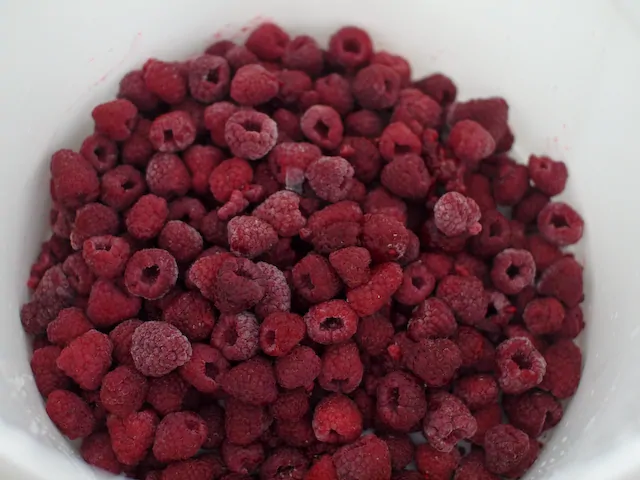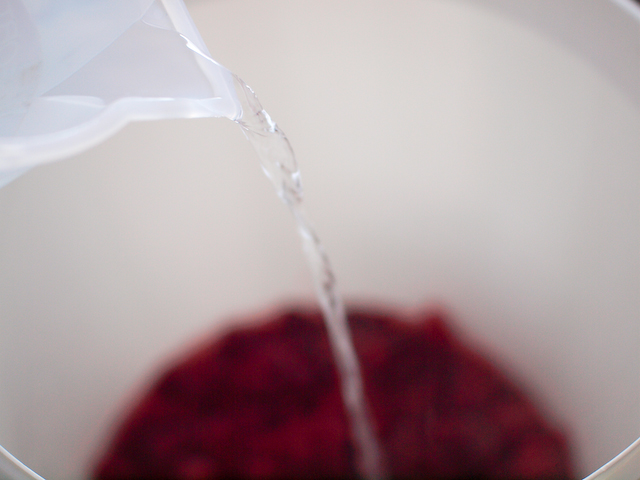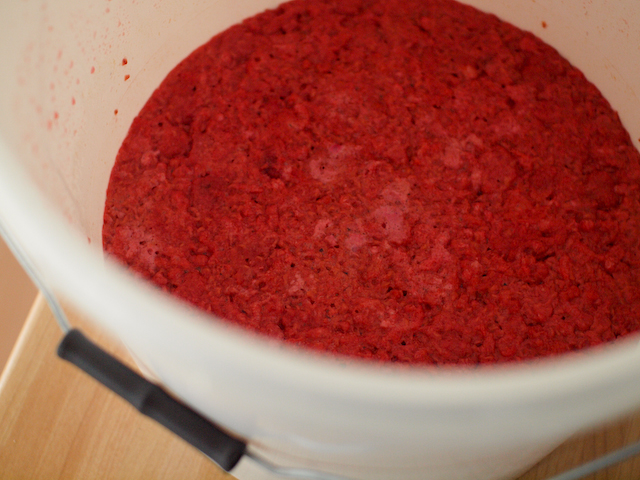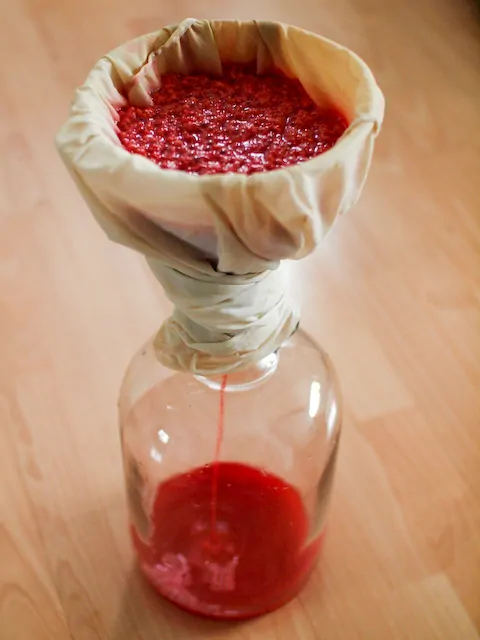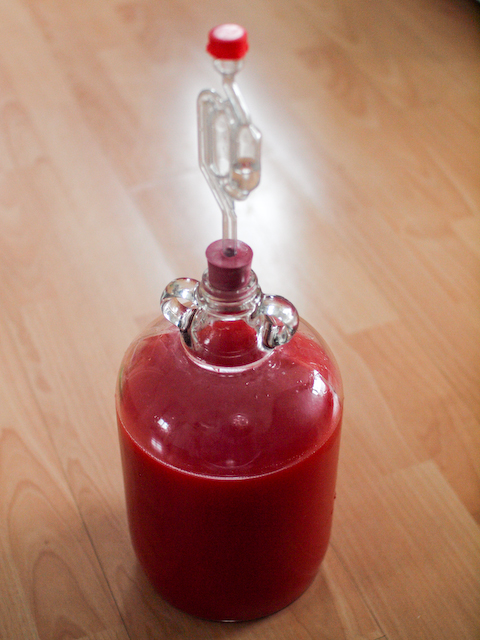Making A Raspberry Wine
There is perhaps nothing quite as refreshing and delicate, yet full of flavour as a Raspberry wine. The delicate berries lend themselves to wine making very easily and give up their flavour, juices and colour readily. This makes raspberries an ideal fruit to use to make your first wine with.
Raspberry Wine
For my wine I have chosen to use frozen raspberries because it’s deepest winter at the point I am making it so I don’t have much of a choice. You can of course use fresh berries. There are benefits to using frozen fruit in wine though as the fruit is already partially broken down for you. If you are using any berry to make wine it’s a good idea to freeze it first anyway even if you have picked them fresh. Their cell structures get broken and the juices pretty much free themselves once they thaw.
Getting Things Ready
So you need some equipment to hand to start making your wine, check out this post for all the basic wine making equipment if you’ve never made wine before.
Everything that comes into contact with your wine needs to be clean and sanitised which is a simple enough task. Cleaning is self explanatory, give everything a wipe over, sanitising it however means we need to kill any bacteria or wild yeasts that may want to spoil the wine. The first thing we’ll be using is a fermentation bin, the easiest way to sanitise this is to fill it with luke warm water and add 1 tablespoon of ordinary unscented household bleach per gallon of water. Allow this to sit for ten minutes and rinse thoroughly. The same mixture of 1 tablespoon of unscented bleach to a gallon of water can be used to sanitise all your equipment before use, just make sure to rinse it thoroughly.
Making The Most From The Raspberries
So for our recipe we are going to make 3.75 litres (5 bottles) of wine from a kilo of raspberries. The recipe is for a dry wine of around 11%. Below is a list of the ingredients used:
1kg (2.2lbs) of Frozen Raspberries
1kg (2.2lbs) of White Sugar
1 Campden tablet (optional)
1 teaspoon Pectic Enzyme
1 teaspoon Mixed Acid
1 teaspoon Yeast nutrient
1 Sachet of Wine Yeast (I used Gervin no.5 White Label, which is a french wine yeast suited to fruit white wines)
Here is what you need to do:
- Take your sanitised fermenting bin and add the frozen raspberries, 500g of sugar and pour over 1.9 litres of boiling water. Give it a stir to dissolve all the sugar and when cool enough you can begin crushing and squeezing all the raspberries with your hands (or a masher) until they are of a pulpy consistency The boiling water helps sanitise the fruit and kill any bacteria that may spoil the wine later on.
- Prepare a sugar syrup with the remaining sugar and 1.9 litres of water by heating in a large pan, stirring to dissolve and bringing to a boil. Boil for a few minutes and then remove from the heat and allow to cool
- Next up we can prepare the yeast by rehydrating it. There may be some instructions on your packet which are best to follow, if not then boil around 200ml of water and add to a sanitised jug with ½ teaspoon of sugar. Allow to cool to around 35°C or luke warm and sprinkle the yeast on the surface, cover and leave for 20-25 minutes.
- Now we are nearly ready to start the exciting part, fermentation. Open up the fermenting bin and add a teaspoon of pectic enzyme and of the mixed acid, then add the completely cooled sugar syrup and stir with a sanitised spoon to ensure everything is thoroughly combined. Now it’s time to add the yeast. Take the jug with the rehydrated yeast in and give it a swirl to make sure everything is in suspension. Go ahead and pour the whole lot into the raspberries and give it a good stir up. Cover this and if you have one attach an airlock to the fermenting bin, if not loosely cover with the lid to ensure no debris or insects can get at it.
- After a day or even several hours your fermentation will begin. The yeast will reproduce and begin consuming the sugar and releasing CO2 and creating alcohol. The day after pitching you should see the raspberries all floating on the surface with foam. This cap needs to be stirred back into the wine once or twice a day for 5 days.
- After five days have elapsed we need to separate the wine and the pulp from each other and continue with the rest of the fermentation. Begin by sanitising your straining bag in a jug of boiling water for five minutes or so, we also need to sanitise a demijohn or carboy, funnel, and a bung and airlock. Whilst you are sanitising your equipment take another 500 grams of sugar and add to a pan with 1.5 litres of water. Dissolve it completely and boil for a couple of minutes.
- Place the funnel in the mouth of the demijohn and sit the straining bag in it. Pour the wine through the funnel gently and allow to strain through. Don’t squeeze the bag too much or you may force the pulp through. Once all the wine is in the demijohn add the cooled sugar mixture and if necessary top up the rest of the demijohn with water.
- The wine will continue fermenting for a week or two and then it will begin to settle down. After a few more weeks the yeast will begin to fall to the bottom of the demijohn and the wine will start clearing.
- When a layer of yeast has settled at the bottom of the vessel we need to move the wine off this sediment within a few weeks to avoid any off flavours and to help clear it further. All that’s needed is another sanitised demijohn and a syphon tube. Syphon the wine into the new vessel and leave until it’s completely clear. If you have never syphoned before then please refer to this article on syphoning.
- When the wine has cleared it is ready to be bottled, if you have a hydrometer check the final gravity, it should read around 1.000. If not sample the wine it should be dry, not noticeably sweet. You may want to rack the wine to a clean vessel before bottling to avoid syphoning any sediment into the bottle. Fill sanitised wine bottles and cork them, the wine should be left for at least 3 months if you can handle that long before sampling.

